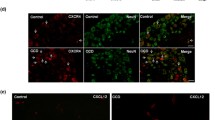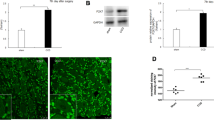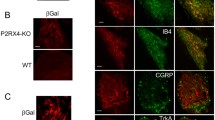Abstract
There are divergences between neuropathic pain and visceralgia in terms of the duration, location, and character of hyperalgesia. It is generally recognized that nociceptive receptors, including P2X receptors, may play different roles in nociceptive mechanisms. The different roles of P2X1–7 receptors have not been fully understood both in neuropathic pain and visceral hyperalgesia. In order to explore the different expressions of P2X1–7 receptors in these two hyperalgesia models, the lumbosacral dorsal root ganglion (DRG) neurons from rat sciatic nerve chronic constriction injury (CCI) model and neonatal colorectal distention (NCRD) model were studied (both the primary nociceptive neuron afferents of those two models projected to the same segment of spinal cord). Both immunohistochemistry (IHC) technique and real-time fluorescence quantitative polymerase chain reaction (RT-PCR) technology were applied to analyze the protein expression levels and nucleic acid of P2X1–7 receptors. We found that except P2X2 and P2X3, the expression levels of P2X1 and P2X5 receptors increased in neuropathic pain while those expression levels of P2X4, P2X6, and P2X7 receptors increased in visceral pain. Our results also suggested that in addition to P2X2/3 heteromeric, other P2X subunits may also involved in generation heteromeric such as P2X1/5 and/or P2X2/5 in neuropathic pain and P2X4/6 and/or P2X4/7 in visceral pain.




Similar content being viewed by others
References
Woolf CJ, Mannion RJ (1999) Neuropathic pain: aetiology, symptoms, mechanisms, and management. Lancet 353(9168):1959–1964
Gebhart GF (2000) Pathobiology of visceral pain: molecular mechanisms and therapeutic implications IV. Visceral afferent contributions to the pathobiology of visceral pain. Am J Physiol Gastrointest Liver Physiol 278(6):G834–G838
Palazzo E et al (2010) Moving towards supraspinal TRPV1 receptors for chronic pain relief. Mol Pain 6:66
Christianson JA et al (2009) Development, plasticity and modulation of visceral afferents. Brain Res Rev 60(1):171–186
Ueda T et al (2009) TRPV3, a thermosensitive channel is expressed in mouse distal colon epithelium. Biochem Biophys Res Commun 383(1):130–134
Mochizuki T et al (2009) The TRPV4 cation channel mediates stretch-evoked Ca2+ influx and ATP release in primary urothelial cell cultures. J Biol Chem 284(32):21257–21264
Burnstock G (2013) Purinergic mechanisms and pain—an update. Eur J Pharmacol 716(1–3):24–40
Murrell-Lagnado RD, Qureshi OS (2008) Assembly and trafficking of P2X purinergic receptors (review). Mol Membr Biol 25(4):321–331
North RA, Jarvis MF (2013) P2X receptors as drug targets. Mol Pharmacol 83(4):759–769
Burnstock G (2009) Purinergic mechanosensory transduction and visceral pain. Mol Pain 5:69
Bennett GJ, Xie YK (1988) A peripheral mononeuropathy in rat that produces disorders of pain sensation like those seen in man. Pain 33(1):87–107
Al-Chaer ED, Kawasaki M, Pasricha PJ (2000) A new model of chronic visceral hypersensitivity in adult rats induced by colon irritation during postnatal development. Gastroenterology 119(5):1276–1285
Mao J et al (1992) Intrathecal MK-801 and local nerve anesthesia synergistically reduce nociceptive behaviors in rats with experimental peripheral mononeuropathy. Brain Res 576(2):254–262
Schmittgen TD, Livak KJ (2008) Analyzing real-time PCR data by the comparative C(T) method. Nat Protoc 3(6):1101–1108
Brass D et al (2012) Using antibodies against P2Y and P2X receptors in purinergic signaling research. Purinergic Signal 8(Suppl 1):61–79
Collo G et al (1996) Cloning of P2X5 and P2X6 receptors and the distribution and properties of an extended family of ATP-gated ion channels. J Neurosci 16(8):2495–2507
Kobayashi K, Yamanaka H, Noguchi K (2013) Expression of ATP receptors in the rat dorsal root ganglion and spinal cord. Anat Sci Int 88(1):10–16
Vulchanova L et al (1997) Immunohistochemical study of the P2X2 and P2X3 receptor subunits in rat and monkey sensory neurons and their central terminals. Neuropharmacology 36(9):1229–1242
Xiang Z, Bo X, Burnstock G (1998) Localization of ATP-gated P2X receptor immunoreactivity in rat sensory and sympathetic ganglia. Neurosci Lett 256(2):105–108
Biggs JE et al (2008) P2X(3) expression is not altered by lingual nerve injury. Neurosci Lett 441(1):110–114
Kage K et al (2002) Alteration of dorsal root ganglion P2X3 receptor expression and function following spinal nerve ligation in the rat. Exp Brain Res 147(4):511–519
Kim C, Chung JM, Chung K (2003) Changes in the gene expression of six subtypes of P2X receptors in rat dorsal root ganglion after spinal nerve ligation. Neurosci Lett 337(2):81–84
Qin M et al (2006) The changes of P2X4 receptor expression in nucleus of tractus solitarius and the dorsal horn of thoracic cord after visceral pain induced by acetic acid. Chin J Neuroanatom 5:15
Keating C et al (2011) P2X7 receptor-dependent intestinal afferent hypersensitivity in a mouse model of postinfectious irritable bowel syndrome. J Immunol 187(3):1467–1474
Martins JP et al (2012) The role of P2X7 purinergic receptors in inflammatory and nociceptive changes accompanying cyclophosphamide-induced haemorrhagic cystitis in mice. Br J Pharmacol 165(1):183–196
North RA (2002) Molecular physiology of P2X receptors. Physiol Rev 82(4):1013–1067
McGaraughty S et al (2003) Effects of A-317491, a novel and selective P2X3/P2X2/3 receptor antagonist, on neuropathic, inflammatory and chemogenic nociception following intrathecal and intraplantar administration. Br J Pharmacol 140(8):1381–1388
Wang WS et al (2014) Electroacupuncture and A-317491 depress the transmission of pain on primary afferent mediated by the P2X3 receptor in rats with chronic neuropathic pain states. J Neurosci Res 92(12):1703–1713
Honore P et al (2006) A-740003 [N-(1-{[(cyanoimino)(5-quinolinylamino) methyl]amino}-2,2-dimethylpropyl)-2-(3,4-dimethoxyphenyl)acetamide], a novel and selective P2X7 receptor antagonist, dose-dependently reduces neuropathic pain in the rat. J Pharmacol Exp Ther 319(3):1376–1385
Acknowledgments
This study was supported by the National Natural Science Foundation of China (No. 81371235 to C.-Y.L. and No. 81473442 to L.C.) and Wuhan Science and Technology Foundation (No. 2014060101010040 to C.-Y.L.).
Author information
Authors and Affiliations
Corresponding author
Rights and permissions
About this article
Cite this article
Chen, L., Liu, Yw., Yue, K. et al. Differential expression of ATP-gated P2X receptors in DRG between chronic neuropathic pain and visceralgia rat models. Purinergic Signalling 12, 79–87 (2016). https://doi.org/10.1007/s11302-015-9481-4
Received:
Accepted:
Published:
Issue Date:
DOI: https://doi.org/10.1007/s11302-015-9481-4




